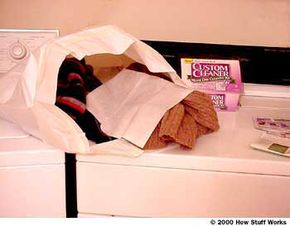
If you have ever done laundry, you've probably run across at least one article of clothing with the label "Dry Clean Only." Whether you're looking to save money or just on a DIY streak, it's normal to want to learn how to dry clean at home. Well, you're in luck.
So, what's so special about fabrics like rayon, silk, and wool blends? Well, these materials may shrink, change colors or lose their shape if washed in water. Garments made of rayon become rumpled and misshapen because water is attracted to the hydrophilic fibers in this fabric. When submerged in water, the fibers expand because water molecules form hydrogen bonds with individual molecules within each fiber. The water molecules also interfere with weak attractions between adjacent fibers, and the fabric as a whole can lose its strength. In order to avoid ruining your favorite shirt, you'll have to resort to other means of cleaning it — namely, dry cleaning.
Advertisement
If you've read How Dry Cleaning Works, you know that dry cleaning removes dirt and other stains from clothes without using water. Despite its name, commercial dry cleaning is not actually a "dry" process. Clothes are immersed in a solvent, usually perchlorethylene (perc), instead of in water. These solvents are especially good at removing oil- and grease-based stains, but they have some drawbacks.
For instance, the solvents used can make you sick if you're exposed to them constantly. This primarily affects the workers who actually run the dry cleaning machines — almost all of the perc is removed from your clothing before it is returned to you. However, some people find the remaining traces of the solvent in their clothes to be very irritating to the eyes, nose and throat.
In the past, your only choice was to go to a commercial cleaner. Now, you have the option of cleaning dry-clean-only clothes without leaving your home. Several home dry cleaning kits now on the market let you launder these delicate garments using your clothes dryer. In this article, we will explore how home dry cleaning works and whether this method is a good option for you and your delicates.
Advertisement
